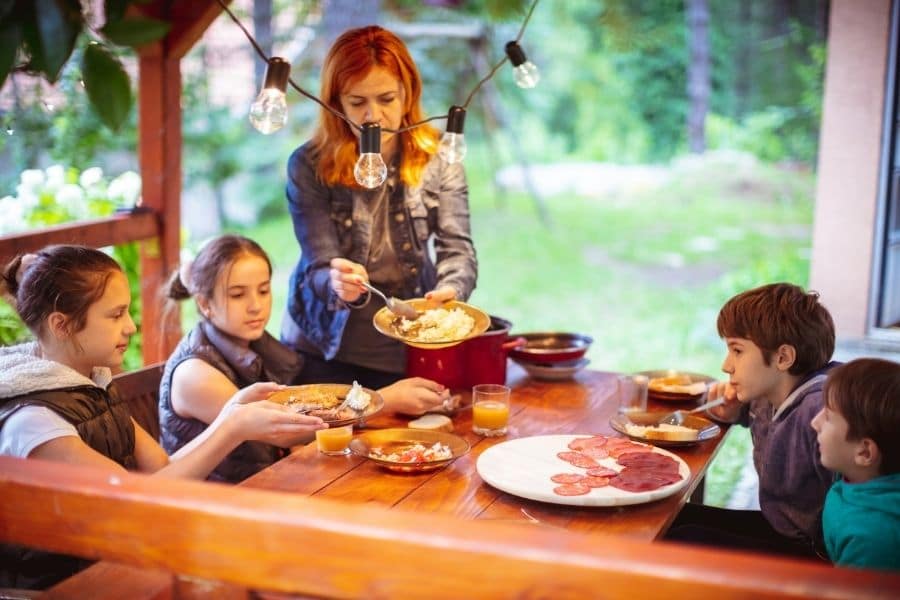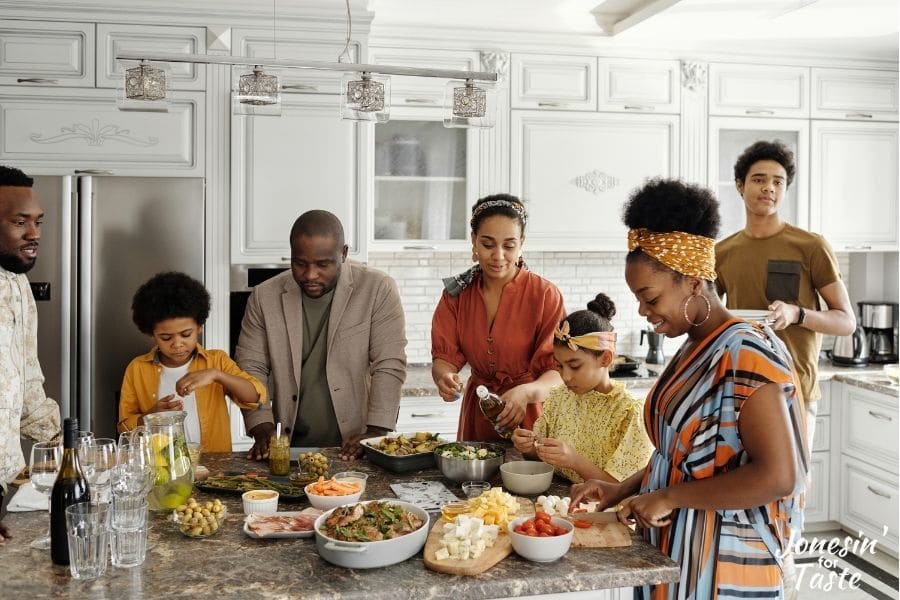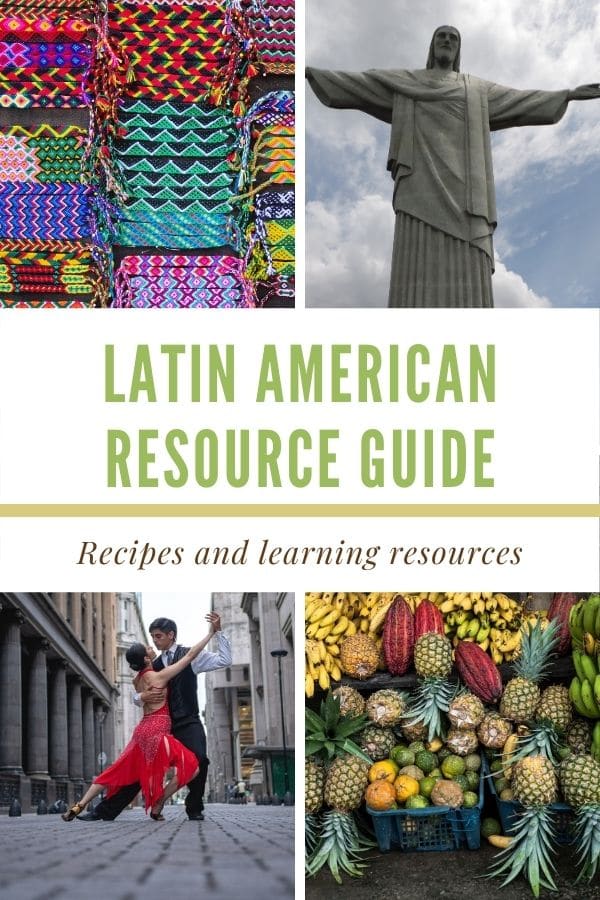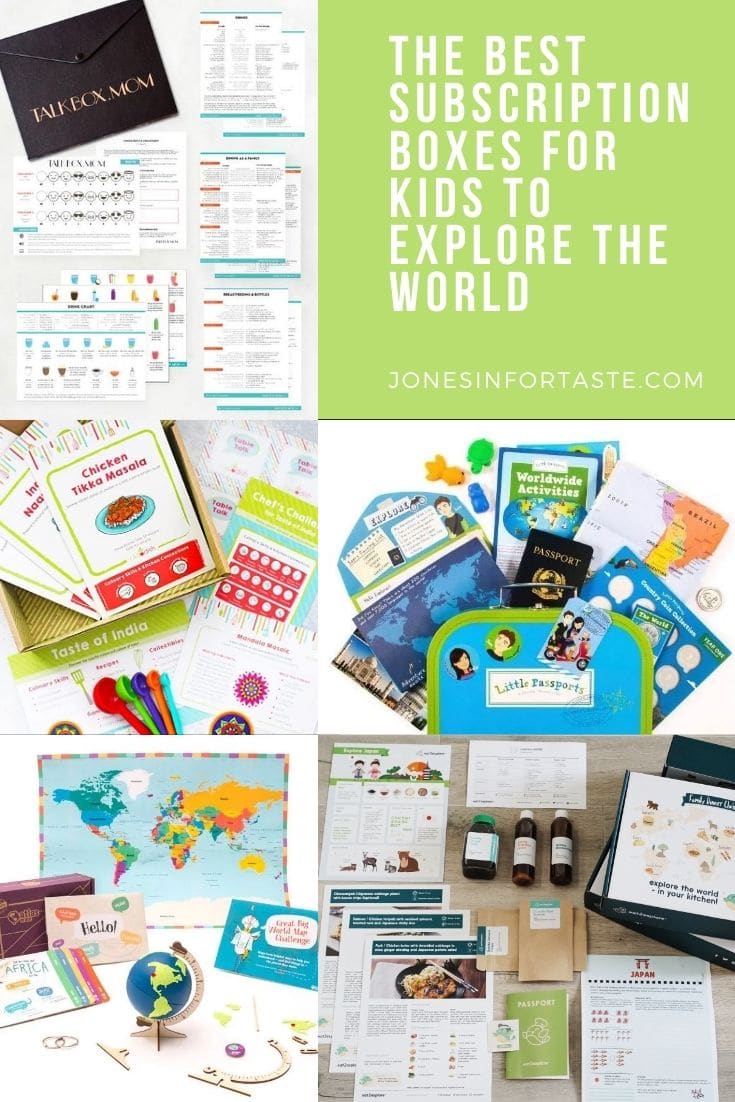Introducing International Foods To Kids
Are you ready to start introducing international foods to your kids? Learn how to do it with tips and tricks to guide your kids towards enjoying global cuisines!

Table of contents
Do you find yourself eating the same meals over and over again? Are you bored with sticking to kid favorites like chicken nuggets and cheesy pasta?
As a mom to 4 kids, I know how hard it can be to convince kids to try new foods! All of my children have been picky eaters at some point. There are still plenty of foods that my children won’t eat. Honestly, there are still foods I don’t like!
I’ll let you in on a secret- kids don’t need to love everything they try! The real goal is to be open to trying new foods and flavors so you can find the new ones you will love.

What is international cuisine?
International cuisine is a really broad term to indicate any style of cooking that is outside of your native country or dominate culture.
Within the US we might think of Mexican, Chinese, Japanese, or French food as an international cuisine. However, living abroad we’ve seen that foods from the US are international cuisine here.
I make this point because it’s important to remember that food styles outside of your own culture will always be “foreign” so we should be mindful of how we talk about other cultures’ foods.
What does global cuisine have to do with cultural globalization?
With increases in technology, immigration and travel, we have greater chances of interacting with other cultures. Being culturally aware is an important skill to learn so we can be respectful and understanding of people and things that are different.
Food is probably the most likely way we will interact with a culture and we want to encourage our children to keep an open mind to try something, be kind even if they don’t like it, and it’s a great vehicle for learning more about other cultures.
How do you introduce a new food to a child?
Rather than just plopping something new down in front of your kids to try, I find more success with introducing new foods in a layered approach which involves learning, cooking, and eating.
My biggest secret to success is to build a variety of positive experiences around new cuisines and ingredients. The more positive experiences children have with food, the more willing they will be to trying something new.

Learning
Sparking children’s interest in a new country or culture can be an incredible gateway to breaking down mental barriers towards food. Learning about a country in general gets them interested in new things and new ways of doing things.
Here are some ways you can learn about new foods:
- Take a virtual field trip. I’ve found when kids are more interested in a particular people and place, they are more curious about the foods as well.
- Show them a video about how the food or dish is made or of people trying the food while traveling. If they see other people enjoying the food they will feel less fear about it.
- Go to a restaurant or to a cultural event and pick a few new foods to share as a family. Remember, just one bite makes it a successful venture.
- Have another family over to make and eat something new. A little bit of positive peer pressure as well as having a good time can go a long way.
Remember the goal isn’t necessarily for them to love it. The goal is for them to be aware of these types of foods or ingredients, hopefully try them, and learn how to talk about them properly. It’s really a bonus if they find new foods or flavors they love.
How to help kids make connections to food and the countries where it’s from?
Let’s take Brazilian food for example. Brazilian food has many of the same ingredients that you find in other South American countries but there’s also lots of crossover between European and African food because of colonization, immigration and the slave trade.
Also, what dishes are popular on the coast are going to be different than what is available inland. Brazil is about the size of the US so you can imagine how many regional foods there are since we have many distinct styles within the US.
Explore the music, language, holidays, dance, architecture, dance, cultural aspects, clothing, and traditions of a country. Are certain foods or dishes only eaten at certain times or for certain holidays?
If you are homeschooling, you can use food as the basis for diving into other subjects like art, geography, humanities, music, social studies and more.
Most importantly, find the connections between the food, the country, and the people who live there. We wouldn’t have the international cuisines we enjoy if it weren’t for the people who make it.

Cooking
Involving kids in the cooking process is a great way to overcome their objections to food. Children are far more willing to eat food that they took the time to make.
If you need general tips on how to get started, check out my guide with my top tips for cooking with kids.
Learn how to easily cook from different cuisines in your kitchen
Youtube is a totally underutilized source! See if you can find a video for the dish you want to make- odds are there is one there. Look for creators who are actually from that culture because they give the best tips and cultural background for the dishes.
Also, start small, especially if your goal is to cook with kids or you’re not really into cooking. Try a drink, sauce, soup, or even a simple dessert since those often are easier and more popular with the kids anyways.
You don’t have to make a full blown meal from scratch. Order in the main dish and make a side dish. Serve those alongside something that you know they will like, like their favorite breads or fruit.

Eating
Physically eating the food is actually the end result of the process of experiencing the food. Before they eat, encourage kids to look at and smell the food and describe what they see and smell.
You can also encourage them to play with it! Is the food sticky or crunchy? Does it tear or break? If kids don’t feel pressure to just stick the food in their mouth they are far more likely to actually try it.
Learn more great strategies to help introduce new foods to kids from my interview with mom and nutritionist Alex Turnbull.
Can we still have cultural food experiences if my kids are picky eaters?
If your children only eat chicken nuggets, don’t stress! Seriously, you can find a version of chicken nuggets all over the world.
For example, there’s chicken katsu in Japan or chicken schnitzel/escalope can be found all over Europe. Many countries have some form of breaded and fried chicken. Try serving one of these versions with their other usual favorites or serve them with sauces from other countries like tonkatsu sauce from Japan or tzatziki sauce from Greece.
Start small and start from wherever they are.
The goal is to get them into the habit of trying new foods and feeling positive and excited about the prospect. If all your kids will eat is cinnamon sugar toast, try sprinkles on buttered bread which is really popular in the Netherlands and is called fairy toast in Australia.
Then you can try moving on to other spreads or jams that are popular elsewhere like orange marmalade or lemon curd.
Baby steps are still wins.
Give them choices
Kids want autonomy and choices. They will be much more open to trying something if they were the ones who picked it out.
Here are some ways to give them choices:
- Have kids choose dinner by giving them 2-3 options to pick from.
- For older children, you can give them a cookbook and have them write up their own list of recipes they would like to try.
- Serve foods family style instead of plating for your kids, do a build your own bar, or serve toppings on the sides.
- Provide several different sauce options to choose from.

What is one thing you can do to get your kids excited about international foods?
Go and pick one recipe or dish to try- right now!
When in doubt, choose a dessert first. It’s never as difficult to get kids to try a treat as it would be to try a vegetable.
For example, if you’re wanting to explore Japanese food, try making mochi which is really easy to make at home. It’s similar in process to making homemade playdough and can be flavored lots of different ways.
If you aren’t ready to make it at home, mochi is becoming quite popular in the US and can be found at many grocery stores. Ice cream filled mochi is my kids favorite.
Join me in the Jonesin’ For Taste community on Instagram where we talk about food, cultural traditions, life as an expat and so much more.
Hopefully I’ve inspired you to start introducing international foods to your children.
What cuisine are you excited to try first? Leave a comment below and let me know!







